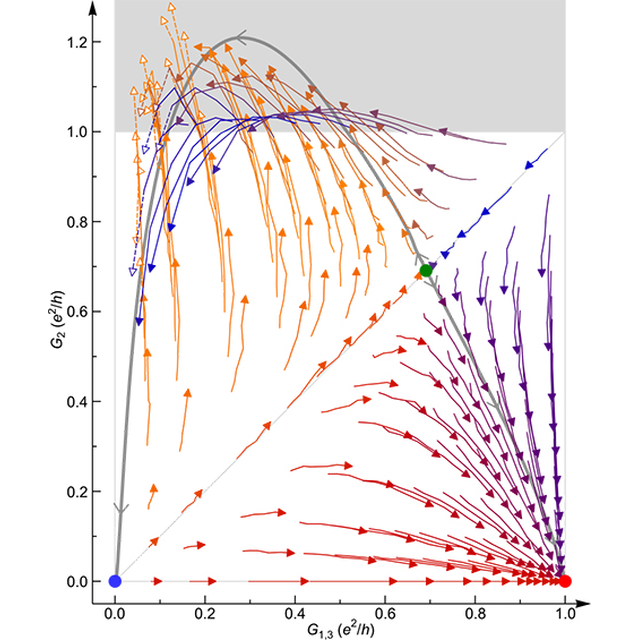News from Institut de physique of CNRS - June 15, 2018 (released in French)
Physicists have observed that the conductance of an electrical current can go beyond its theoretical quantum limit, by exploiting the correlations developing in the vicinity of a quantum phase transition.
How high can the electrical conductance be? In contrast to resistance, this quantity measures the ease with which current flows. In fundamental physics, conductance is a very important characterization tool. In electronic chips, increasing the conductance of interconnects would reduce heating that limits performance.
The standard theory of quantum transport, however, predicts an upper limit for conductance, even in the absence of defects. This limitation reflects the fact that electrons crossing a narrow conductor must pass one after the other, each with a minimal extension imposed by quantum mechanics. However, when the interactions are very strong, the electrons can no longer be considered separately. They are then in an intermediate state, between free electrons and superconductivity. The limit can then be exceeded by a collective effect between the electrons, similar to that of a viscous behavior of an electronic fluid. This phenomenon has just been observed in graphene at the University of Manchester.
Researchers have now also observed it in a quantum circuit where the magnitude of the overshoot of the standard conductance limit, as well as the temperature range where it occurs, can be controlled in situ. To do this, physicists at the Centre de nanosciences et de nanotechnologies/Centre for Nanoscience and Nanotechnology - C2N (CNRS / UPSud / Univ Paris Diderot), in collaboration with theoreticians at the University College Dublin, University of Paris-Sud and University of Paris Diderot, are exploiting the electronic correlations that develop in the vicinity of a quantum phase transition, and which occur at a few thousandths of degrees above absolute zero.
At the heart of the quantum circuit is a metal island tuned so that the increase of its charge by an electron does not change its energy. This is fundamental, because then the system will not be frozen in one of these two states (with or without an additional electron charge), even at the lowest temperatures. In the contrary case, the system would freeze in the state of lower energy and one would lose this degree of freedom of a charge addition. However, it is the coupling of this charge with the electrons entering and leaving the island by three small individually adjustable contacts that generates strong correlations between these electrons, and which leads to the appearance of a quantum phase transition. The very existence and magnitude of the overshoot of the standard conductance limit is then controlled by the degree of symmetry between the different contacts.
This work published in the journal Science opens a research path for low-power electronics. The implemented device has no applications but is a model study system. More generally, this work is part of the exploration of a wide variety of unconventional phenomena associated with quantum phase transitions.
Figure: Evolution of the conductances of 3 quantum contacts connected in parallel to a small metal island as a function of the temperature. Each colored arrow represents the variation of the conductance G2 of one of the contacts as a function of the conductance of the other two contacts (set such as G1 = G3) when the temperature varies from 55 mK to 8 mK for different initial configurations. The conductance G2 exceeds the quantum limit e2 / h (e is the charge of the electron and h the Planck constant) in the gray zone due to strong electronic correlations. The gray lines represent the theoretical predictions (NRG) for a very small asymmetry. © C2N, CNRS/UPSud/Univ. Paris Diderot
Reference
Tunable quantum criticality and super-ballistic transport in a “charge” Kondo circuit
Z. Iftikhar, A. Anthore, A. K. Mitchell, F. D. Parmentier, U. Gennser, A. Ouerghi, A. Cavanna, C. Mora, P. Simon, F. Pierre
Science (2018), doi:10.1126/science.aan5592
- Read the article on ArXiv
- Centre de nanosciences et de nanotechnologies - C2N (CNRS/Université Paris-Sud-Université Paris-Saclay)
- Laboratoire Pierre Aigrain – LPA (CNRS/ENS Paris/Univ. Paris Diderot/Sorbonne Université)
- Laboratoire de physique des solides – LPS (CNRS/Univ. Paris-Sud)
- University College Dublin, Irlande
Contact
Frédéric Pierre, CNRS senior researcher









